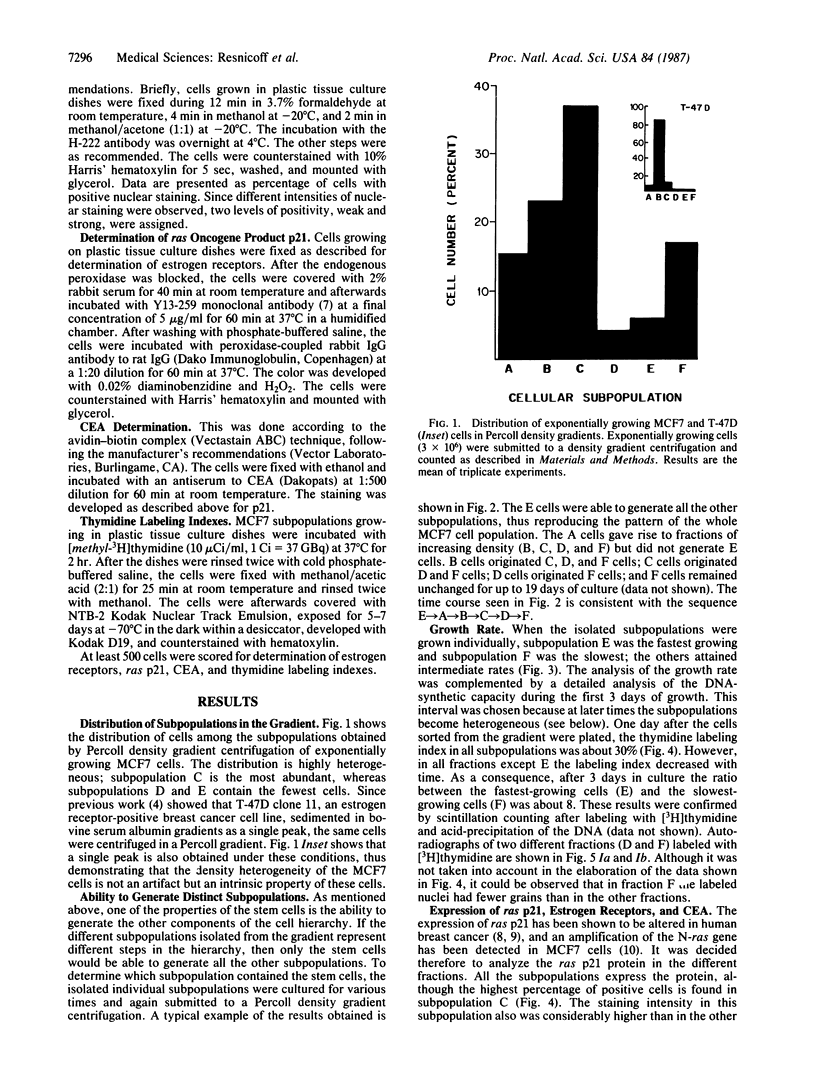Abstract
Exponentially growing MCF7 human breast cancer cells were separated in Percoll gradients into six different fractions of increasing density (A to F). These fractions could be subcultured and were found to contain different cellular subpopulations as defined by the following criteria: ability to generate other cellular subpopulations; growth rate; DNA synthesis; and expression of estrogen receptors, ras oncogene-encoded protein p21, and carcinoembryonic antigen. One of the minor fractions (E), which contained about 5% of the total cell number, appeared to contain the stem cells, on the basis of the following criteria: (i) its ability to reproduce the other cellular subpopulations, (ii) its high rate of growth and DNA synthesis, and (iii) the inability of the other subpopulations to generate it. The most differentiated subpopulation appeared to be the densest one (F), since it was the slowest growing and appeared to be the end point of the other subpopulations.
Full text
PDF




Images in this article
Selected References
These references are in PubMed. This may not be the complete list of references from this article.
- Buick R. N., Pollak M. N. Perspectives on clonogenic tumor cells, stem cells, and oncogenes. Cancer Res. 1984 Nov;44(11):4909–4918. [PubMed] [Google Scholar]
- Butler W. B., Berlinski P. J., Hillman R. M., Kelsey W. H., Toenniges M. M. Relation of in vitro properties to tumorigenicity for a series of sublines of the human breast cancer cell line MCF-7. Cancer Res. 1986 Dec;46(12 Pt 1):6339–6348. [PubMed] [Google Scholar]
- DeBortoli M. E., Abou-Issa H., Haley B. E., Cho-Chung Y. S. Amplified expression of p21 ras protein in hormone-dependent mammary carcinomas of humans and rodents. Biochem Biophys Res Commun. 1985 Mar 15;127(2):699–706. doi: 10.1016/s0006-291x(85)80218-7. [DOI] [PubMed] [Google Scholar]
- Furth M. E., Davis L. J., Fleurdelys B., Scolnick E. M. Monoclonal antibodies to the p21 products of the transforming gene of Harvey murine sarcoma virus and of the cellular ras gene family. J Virol. 1982 Jul;43(1):294–304. doi: 10.1128/jvi.43.1.294-304.1982. [DOI] [PMC free article] [PubMed] [Google Scholar]
- Graham K. A., Richardson C. L., Minden M. D., Trent J. M., Buick R. N. Varying degrees of amplification of the N-ras oncogene in the human breast cancer cell line MCF-7. Cancer Res. 1985 May;45(5):2201–2205. [PubMed] [Google Scholar]
- Hamburger A. W., Salmon S. E. Primary bioassay of human tumor stem cells. Science. 1977 Jul 29;197(4302):461–463. doi: 10.1126/science.560061. [DOI] [PubMed] [Google Scholar]
- Ohuchi N., Thor A., Page D. L., Hand P. H., Halter S. A., Schlom J. Expression of the 21,000 molecular weight ras protein in a spectrum of benign and malignant human mammary tissues. Cancer Res. 1986 May;46(5):2511–2519. [PubMed] [Google Scholar]
- Podhajcer O. L., Bravo A. I., Sorin I., Guman N., Cerdeiro R., Mordoh J. Determination of DNA synthesis, estrogen receptors, and carcinoembryonic antigen in isolated cellular subpopulations of human breast cancer. Cancer. 1986 Aug 1;58(3):720–729. doi: 10.1002/1097-0142(19860801)58:3<720::aid-cncr2820580320>3.0.co;2-s. [DOI] [PubMed] [Google Scholar]
- Soule H. D., Vazguez J., Long A., Albert S., Brennan M. A human cell line from a pleural effusion derived from a breast carcinoma. J Natl Cancer Inst. 1973 Nov;51(5):1409–1416. doi: 10.1093/jnci/51.5.1409. [DOI] [PubMed] [Google Scholar]
- Weisenthal L. M., Lippman M. E. Clonogenic and nonclonogenic in vitro chemosensitivity assays. Cancer Treat Rep. 1985 Jun;69(6):615–632. [PubMed] [Google Scholar]
- Yang N. S., Soule H. D., McGrath C. M. Expression of murine mammary tumor virus-related antigens in human breast carcinoma (MCF-7) cells. J Natl Cancer Inst. 1977 Nov;59(5):1357–1367. doi: 10.1093/jnci/59.5.1357. [DOI] [PubMed] [Google Scholar]
- Zarbl H., Sukumar S., Arthur A. V., Martin-Zanca D., Barbacid M. Direct mutagenesis of Ha-ras-1 oncogenes by N-nitroso-N-methylurea during initiation of mammary carcinogenesis in rats. 1985 May 30-Jun 5Nature. 315(6018):382–385. doi: 10.1038/315382a0. [DOI] [PubMed] [Google Scholar]



